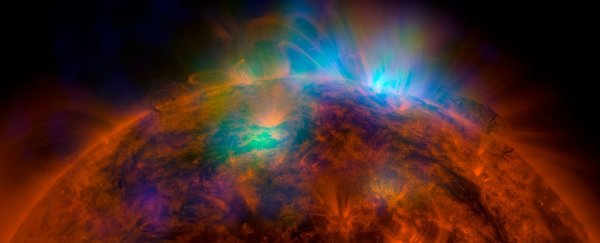It takes a little over 8 minutes for sunlight to journey across the chasm of space to Earth, but it took scientists less than 7 to help solve one of the Sun's most paradoxical riddles.
A sounding rocket flight launched in 2014 only had that short window to measure X-rays on the Sun before falling back to Earth, but the readings it took could explain the star's most unintuitive quirk: why the surface of the Sun isn't as hot as the atmosphere above it.
This discrepancy is not a small thing. The visible surface of the Sun, called the photosphere, isn't exactly cool at around 5,500 degrees Celsius (or 10,000 degrees Fahrenheit) – but its outer atmosphere, or corona, gets hundreds of times hotter, up to several million kelvins.
One possible explanation for the corona's intense heat is nanoflares: small solar explosions produced by the Sun that release energy and plasma into the corona, propping up its insanely hot temperatures.
This idea was first proposed back in the 1960s, and while it's been studied since, it's been difficult to detect these faint micro-explosions, which are thought to ripple across the photosphere thousands of times every second.
Now, thanks to a new study led by Shin-nosuke Ishikawa from the Japan Aerospace Exploration Agency, we've secured our best glimpse of the phenomena yet.
Ishikawa and fellow researchers took their readings during a flight of the Focusing Optics X-ray Solar Imager (FOXSI-2) sounding rocket, which launched from New Mexico in December 2014.
Amidst the Sun's busy backdrop of swirling heat and radiation, capturing nanoflares in the act is "observationally challenging" the team explains, given just how subtle these explosions can be.
"We think nanoflares range from a billion to a million times smaller than a regular solar flare," Ishikawa told Space.com.
While that might be the case, don't mistake them for puny misfires. As Ishikawa explains, they still pack the explosive punch of about 1019 joules, or around 10 billion tonnes of TNT.
By focussing FOXSI-2's X-ray optics at an active region of the Sun that didn't show any visible large-scale flaring activity, the team detected very energetic X-ray emissions that they say are a signature of plasma heated to more than 10 million Kelvin.
These readings were possible because FOXSI-2's instruments are about 100 times more sensitive than what scientists have previously used to observe this kind of activity on the Sun, and the researchers explain the plasma temperature they saw could only be generated by nanoflares.
Researchers have previously explained the corona's scorching heat as a byproduct of magnetic field activity in the Sun's outer atmosphere, but according to Ishikawa's team, this couldn't account for the plasma temperatures detected by FOXSI-2.
Next, the researchers want to look at investigating how many nanoflares are exploding on the Sun, and measure the energy contained in them.
For this, they're currently working on a satellite that can record nanoflare explosions, but before that happens, there are more sounding rockets to fly.
FOXSI-2's successor is scheduled for launch in August 2018, and its upgraded internals could tell us even more about what's behind the hottest atmosphere in the Solar System.
"With FOXSI-3, we're trying to push the sensitivity as far as possible," team member Steven Christe from NASA's Goddard Space Flight Centre explained in a release last year.
The findings are reported in Nature Astronomy.
